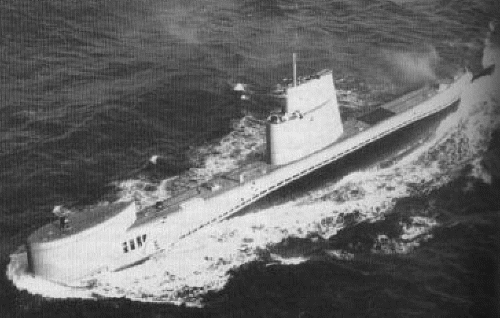
NAVYPEDIA
 Support the project with paypal
Support the project with paypal
Photo

K2 1952
Ships
| No | Name | Yard No | Builder | Laid down | Launched | Comm | Fate |
|---|---|---|---|---|---|---|---|
| SSK1, 7.1959- SST3, 8.1972- SS-T3 | K1, 12.1955- Barracuda | 133 | Electric Boat, Groton | 1.7.1949 | 2.3.1951 | 10.11.1951 | TS 7.1959, stricken 10.1973 |
| SSK2, 8.1959- SS551 | K2, 12.1955- Bass | Mare Island N Yd, Vallejo | 23.2.1950 | 2.5.1951 | 16.11.1951 | stricken 4.1965 | |
| SSK3, 8.1959- SS552 | K3, 12.1955- Bonita | Mare Island N Yd, Vallejo | 29.5.1950 | 21.6.1951 | 11.1.1952 | stricken 4.1965 |
Technical data
| Displacement standard, t | 765 |
|---|---|
| Displacement normal, t | / 1160 |
| Length, m | 59.8 |
| Breadth, m | 7.50 |
| Draught, m | 4.40 |
| No of shafts | 2 |
| Machinery | 2 General Motors diesel-generators, 2 General Electric electric motors |
| Power, h. p. | 1125 / 1050 |
| Max speed, kts | 13 / 8.5 |
| Fuel, t | diesel oil 189 |
| Endurance, nm(kts) | 9000(10) / |
| Armament | 4 - 533 Mk 47 TT (bow, 8) |
| Electronic equipment | BPS-12 radar, BQR-3, BQR-4 sonars |
| Complement | 37 |
| Diving depth operational, m | 120 |
Standard scale images

Barracuda 1963

K1 1951
Graphics
Project history
These three small diesel submarines were intended as prototypes of a mass produced ASW submarine, which would ambush enemy submarines as they emerged from their bases. The principal requirements were quietness, low cost and an effective passive sonar, the latter being carried in an enlarged bow sonar dome. They were later criticised as too small for habitability or for sea-keeping, and Tullibee was an attempt to update the ASW submarine (SSK) concept. In view of limited resources available for new construction during the early postwar period, an SSK conversion of fleet submarines was developed as a mobilization measure, and the GUPPY submarine conversions were all designed to permit later modification to SSK standard.
Modernizations
None.
Naval service
No significant events.
 HOME
HOME FIGHTING SHIPS OF THE WORLD
FIGHTING SHIPS OF THE WORLD UNITED STATES OF AMERICA
UNITED STATES OF AMERICA SUBMARINES
SUBMARINES K1 submarines (1951 - 1952)
K1 submarines (1951 - 1952)
